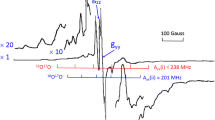Abstract
The possibility of the use of ESR for investigating coordination compounds formed by ions of transition metals having no d electrons has been demonstrated on the basis of an analysis of the data obtained on the low-temperature photolysis of labile complexes of titanium(IV), vanadium(V), and molybdenum(VI). Under the proposed procedure, the d∘ complex is converted into a d1 complex by means of photochemical reduction under conditions which are favorable to the maintenance of the coordination sphere unchanged, its ESR spectrum is recorded, and the parameters obtained are used to characterize the composition, structure, symmetry, and degree of aggregation of the original compound in the solution. The use of this procedure is restricted to the investigation of systems in which photochemical redox conversions are realized according to an outer-sphere mechanism; however, it may also be useful in the interpretation of the results of the photolysis of compounds which undergo inner-sphere conversions.
Similar content being viewed by others
Literature cited
A. I. Kryukov, V. P. Sherstyuk, and I. I. Dilung, Light-Induced Electron Transfer and its Practical Aspects [in Russian], Naukova Dumka, Kiev (1982).
V. Balzani and V. Carassiti, Photochemistry of Coordination Compounds, Academic Press, London-New York (1970).
A. W. Adamson and P. D. Fleischauer (editors), Concepts of Inorganic Photochemistry, Wiley, New York and other cities (1975).
J. D. Winerfordner and P. A. John, “Solvents for phosphorimetry,” Anal. Chem.,35, No. 13, 2211–2212 (1963).
F. A. Cotton and G. Wilkinson, Advanced Inorganic Chemistry, Interscience, New York (1966).
S. Ya. Kuchmii, A. V. Korzhak, and A. I. Kryukov, “Photolysis of chlorine-containing complexes of vanadium(V) in aqueous solutions,” Ukr. Khim.,50, No. 10, 1050–1054 (1984).
N. B. Kalinichenko, I. N. Marov, and A. N. Ermakov, “ESR investigation of oxochloro complexes of vanadium(IV),” Zh. Neorg. Khim.,17, No. 12, 3250–3252 (1972).
A. A. Ivakin, L. D. Kurbatova, and M. V. Kruchinina, “Spectrophotometric investigation of hydrochloric acid solutions of vanadium(V),” ibid.,30, No. 1, 249–252 (1985).
S. Ya. Kuchmii, T. I. Serdyukova, V. A. Il'yushenok, and A. I. Kryukov, “Photolysis of solutions of molybdenum(VI) complexes in hydrochloric acid,” Teor. Éksp. Khim.,17, No. 3, 410–414 (1981).
I. N. Marov, Yu. N. Dubrov, G. A. Evtikova, et al., “ESR investigation of the state of molybdenum(V) in solutions of hydrochloric acid, hydrobromic acid, and hydroiodic acid,” Zh. Neorg. Khim.,15, No. 8, 2227–2237 (1970).
I. N. Marov and N. A. Kostromina, ESR and NMR in the Chemistry of Coordination Compounds [in Russian], Nauka, Moscow (1979).
R. Feld and P. L. Cowe, Organic Chemistry of Titanium, Butterworths, London (1965).
S. Ya. Kuchmii, A. V. Korzhak, and A. I. Kryukov, “State of titanium(III) in ethanolic solutions containing additions of hydrogen chloride,” Koord. Khim.,10, No. 11, 1505–1507 (1984).
S. Ya. Kuchmii and A. I. Kryukov, “Photochemical conversions of coordination compounds of titanium(IV) in alcoholic matrices,” Teor. Éksp. Khim.,20, No. 4, 421–427 (1984).
H. M. Gladney and J. D. Swalen, “Theory of EPR of Ti3+ in trigonal environments,” J. Chem. Phys.,42, No. 6, 1999–2010 (1965).
J. J. Davies and J. E. Wertz, “Trivalent titanium in tetragonal symmetry in MgO and CaO,” J. Magn. Reson.,1, No. 4, 500–508 (1969).
J. E. Wertz and J. R. Bolton, Electron Spin Resonance; Elementary Theory and Practical Applications, McGraw-Hill, New York (1972).
S. Ya. Kuchmii, S. V. Kulik, A. V. Korzhak, and A. I. Kryukov, “Photochemical conversions of thiocyanato complexes of titanium in ethanolic solutions,” Ukr. Khim. Zh.,52, No. 7, 710–714 (1986).
S. Ya. Kuchmii, S. V. Kulik, A. V. Korzhak, and A. I. Kryukov, “Study of thiocyanate-containing coordination compounds of titanium(III) in alcoholic solutions by electronic and ESR spectroscopy,” Teor. Éksp. Khim.,21, No. 5, 560–567 (1985).
S. Ya. Kuchmii, A. V. Korzhak, and A. I. Kryukov, “Photolysis of titanium(IV) compounds in hydroalcoholic matrices,” Ukr. Khim. Zh.,52, No. 2, 158–162 (1986).
Author information
Authors and Affiliations
Additional information
Translated from Teoreticheskaya i Éksperimental'naya Khimiya, Vol. 25, No. 2, pp. 197–203, March–April, 1989.
Rights and permissions
About this article
Cite this article
Kryukov, A.I., Kuchmii, S.Y. Combination of low-temperature photolysis and ESR spectroscopy as a method for investigating nonparamagnetic complexes. Theor Exp Chem 25, 179–184 (1989). https://doi.org/10.1007/BF01135008
Received:
Issue Date:
DOI: https://doi.org/10.1007/BF01135008




